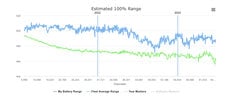SilentWarp
Member
This is best for the battery, AFAIK. However, is the battery the most important thing, or is convenient road tripping more important to the reader?
I would never "charge only enough to get to the next charger" since it makes no sense to interrupt my lunch to go unplug and move the car before I finish. I will do that to avoid idle fees, but otherwise I will let it supercharge to 100%.
Read again, I said "on long trips, you should only charge enough to get to next charger (+ a bit more)". I was not referring to daily usage
Yes, agreed that you shouldn't make a big deal about degradation since 90% of Tesla owners will certainly move on to next shiny thing before degradation makes a big difference in your lives.



